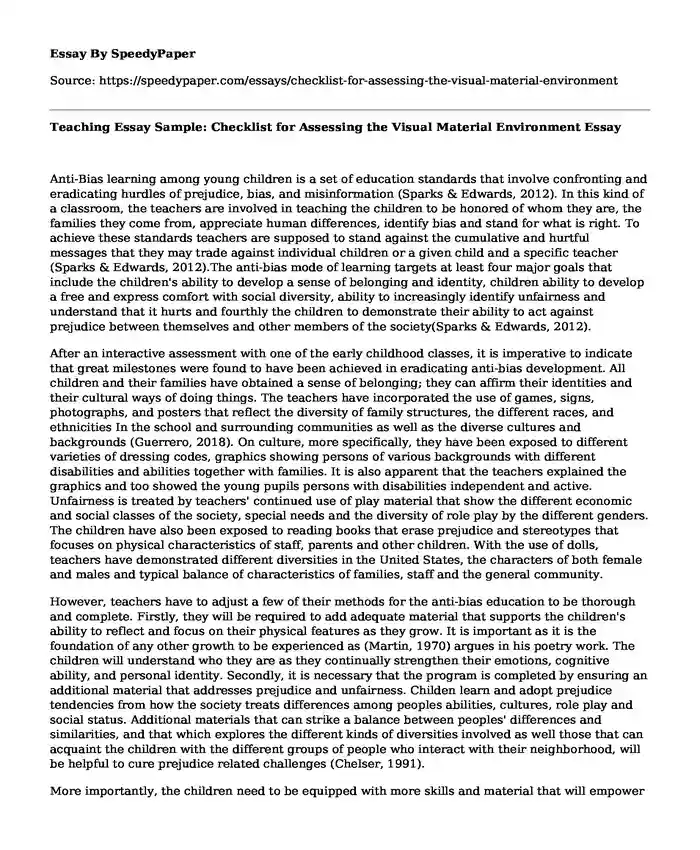
| Type of paper: | Creative writing |
| Categories: | Teaching Discrimination |
| Pages: | 3 |
| Wordcount: | 740 words |
Anti-Bias learning among young children is a set of education standards that involve confronting and eradicating hurdles of prejudice, bias, and misinformation (Sparks & Edwards, 2012). In this kind of a classroom, the teachers are involved in teaching the children to be honored of whom they are, the families they come from, appreciate human differences, identify bias and stand for what is right. To achieve these standards teachers are supposed to stand against the cumulative and hurtful messages that they may trade against individual children or a given child and a specific teacher (Sparks & Edwards, 2012).The anti-bias mode of learning targets at least four major goals that include the children's ability to develop a sense of belonging and identity, children ability to develop a free and express comfort with social diversity, ability to increasingly identify unfairness and understand that it hurts and fourthly the children to demonstrate their ability to act against prejudice between themselves and other members of the society(Sparks & Edwards, 2012).
After an interactive assessment with one of the early childhood classes, it is imperative to indicate that great milestones were found to have been achieved in eradicating anti-bias development. All children and their families have obtained a sense of belonging; they can affirm their identities and their cultural ways of doing things. The teachers have incorporated the use of games, signs, photographs, and posters that reflect the diversity of family structures, the different races, and ethnicities In the school and surrounding communities as well as the diverse cultures and backgrounds (Guerrero, 2018). On culture, more specifically, they have been exposed to different varieties of dressing codes, graphics showing persons of various backgrounds with different disabilities and abilities together with families. It is also apparent that the teachers explained the graphics and too showed the young pupils persons with disabilities independent and active. Unfairness is treated by teachers' continued use of play material that show the different economic and social classes of the society, special needs and the diversity of role play by the different genders. The children have also been exposed to reading books that erase prejudice and stereotypes that focuses on physical characteristics of staff, parents and other children. With the use of dolls, teachers have demonstrated different diversities in the United States, the characters of both female and males and typical balance of characteristics of families, staff and the general community.
However, teachers have to adjust a few of their methods for the anti-bias education to be thorough and complete. Firstly, they will be required to add adequate material that supports the children's ability to reflect and focus on their physical features as they grow. It is important as it is the foundation of any other growth to be experienced as (Martin, 1970) argues in his poetry work. The children will understand who they are as they continually strengthen their emotions, cognitive ability, and personal identity. Secondly, it is necessary that the program is completed by ensuring an additional material that addresses prejudice and unfairness. Childen learn and adopt prejudice tendencies from how the society treats differences among peoples abilities, cultures, role play and social status. Additional materials that can strike a balance between peoples' differences and similarities, and that which explores the different kinds of diversities involved as well those that can acquaint the children with the different groups of people who interact with their neighborhood, will be helpful to cure prejudice related challenges (Chelser, 1991).
More importantly, the children need to be equipped with more skills and material that will empower them to deal with discriminatory actions. For instance, the class should be equipped with reading brailles for the blind and materials that support the American sign languages. Other material that shows or indicate different people with different levels of disabilities will be helpful. For example, there could more artwork showing personalities using brailles and hearing aids equipment. With this in mind, the children will grow to have a wholesome life that is free from bias and prejudice.
References
Chelser, A. M. (1991). Dealing with Prejudice and Conflict in the Classroom: The Pink Triangle Exercise. Teaching Sociology, 173-81.
Guerrero, A. (2018, January). 19 Ideas to Promote More Creativity in Your Classroom. Retrieved March 27, 2018, from https://www.canva.com/learn/19-ideas-to-promote-more-creativity-in-your-classroom/
Louise Derman-Sparks, J. O. (2012). Anti-Bias Education for Young Children and Ourselves. Retrieved March 27, 2018, from https://www.naeyc.org/sites/default/files/globally-shared/downloads/PDFs/resources/topics/Chap1_Anti-Bias%20Education.pdf
Martin, B. (1970). I am freedom's child. Glendale.
Cite this page
Teaching Essay Sample: Checklist for Assessing the Visual Material Environment. (2022, Apr 14). Retrieved from https://speedypaper.net/essays/checklist-for-assessing-the-visual-material-environment
Request Removal
If you are the original author of this essay and no longer wish to have it published on the SpeedyPaper website, please click below to request its removal:
- Free Essay about William Faulkner and Ernest Hemingway
- Literary Essay Example
- Essay Sample with a Brain Teaser
- Business Essay Sample on Partnerships and Corporations
- Paper Proposal Sample: The Change and Construction of the Roads
- Essay Sample on Case: 19-2019
- An Occurrence at Owl Creek Bridge by Ambrose Bierce. Paper Example
Popular categories




